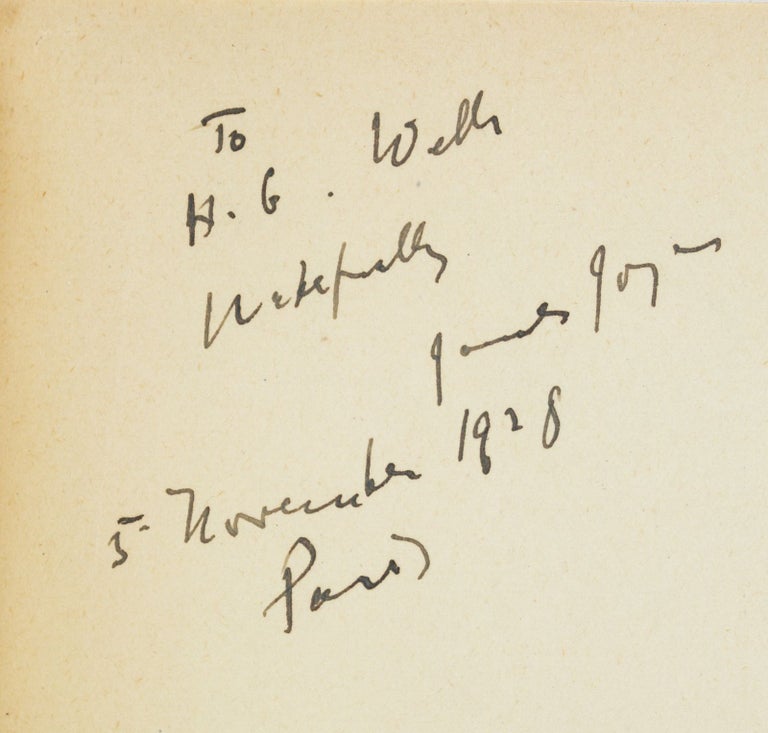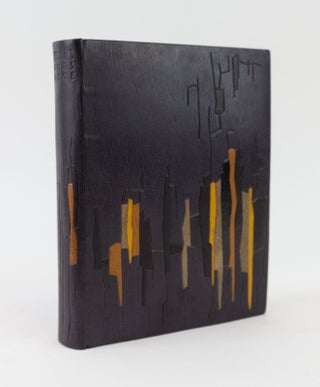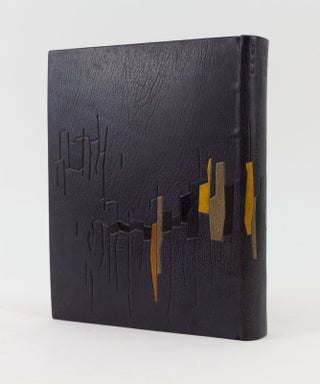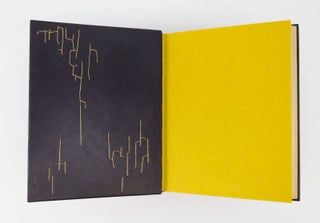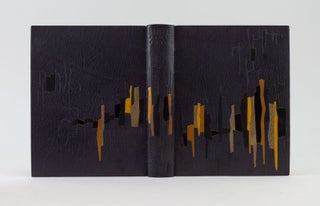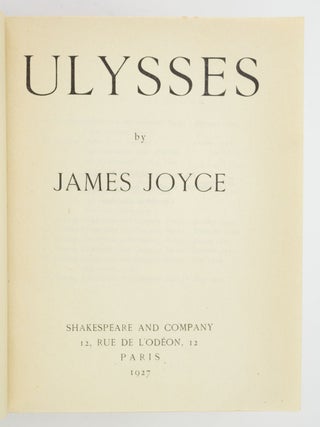ULYSSES.
(Paris: Shakespeare and Company, May 1927). 205 x 160 mm. (8 1/8 x 6 1/4"). 4 p.l. (first blank), 735 pp. Ninth Printing of the First Edition.
DRAMATIC DARK BLUE-GRAY CRUSHED MOROCCO, BLIND-TOOLED AND INLAID TO AN ABSTRACT DESIGN, BY SALLY LOU SMITH (stamp-signed with her initials in gilt on rear doublure), with overall wraparound design of inlaid elongated, irregular-shaped pieces of black, gray, blue, tan, and yellow morocco with blind-tooled lines extending from these shapes, MATCHING MOROCCO DOUBLURES tooled in gilt with branch-like lines, yellow handmade free endpapers, gray flyleaves, all edges gilt. In the matching morocco-backed clamshell box. Front flyleaf INSCRIBED BY JOYCE TO H. G. WELLS: "To / H. G. Wells / Respectfully / James Joyce / 5 November 1928 / Paris." Slocum and Cahoon 17. ◆Isolated faint foxing or marginal spots, but a clean, fresh copy with few signs of use, in a new binding.
This later printing of what is generally recognized to be the most important 20th century novel in English is inscribed by the author to one of his earliest and most important supporters, and is offered in a binding by an influential Designer Bookbinder. First issued in 1922, "Ulysses" rocked the literary world. J. B. Priestley, writing in the "Clarion" in 1934, said what most scholars and critics acknowledge--that "as a literary feat, an example of virtuosity in narration and language, it is an astounding creation. Nobody who knows anything about writing can read the book and deny its author, not merely talent, but sheer genius." Our copy was presented by Joyce to H. G. Wells (1866-1946), whose support of "Portrait of the Artist as a Young Man" was instrumental in establishing Joyce's literary reputation. Reviewing that book in 1916, Wells praised "its quintessential and unfailing reality. One believes in Stephen Dedalus as one believes in few characters in fiction." He considered "Portrait" to be "by far the most living and convincing picture that exists of an Irish Catholic upbringing," and noted how sharply it contrasted the Irish and the English: "No single book has ever shown how different they are, as completely as this most memorable novel." The two men did not meet until 12 years later, in Paris, at which time Joyce inscribed the present copy of his masterwork to Wells. At the same time, Joyce presented Wells with some excerpts of what would become "Finnegan's Wake." On 23 November 1928, Wells wrote to Joyce from his winter home in the south of France, expressing his regret that he could not promote these latest works with the same enthusiasm: "I have enormous respect for your genius dating from your earliest books and I feel now a great personal liking for you but you and I are set upon absolutely different courses. . . . I want a language and statement as simple and clear as possible. . . . Who the hell is this Joyce who demands so many waking hours of the few thousand I have still to live for a proper appreciation of his quirks and fancies and flashes of rendering?" Still, Wells acknowledged, "Your work is an extraordinary experiment and I would go out of my way to save it from destructive or restrictive interruption."
The abstract binding by distinguished modern artisan Sally Lou Smith evokes a journey: as the multicolored inlays march from the rear edge around the spine and across the front against a grim, gray ground, Bloom's peregrinations through Dublin and the characters he encounters seem to be brought to mind. Born in the United States, Smith (1925-2007) spent several years in France, then settled in 1958 in London. There, she spent four and a half years learning bookbinding under John Corderoy at Camberwell School of Arts & Crafts before beginning to work out of her own bindery in 1963. Her work has been widely honored both in her early days (she won the bookbinding award given by Major J. R. Abbey in 1965) and for many years since (among others, she won three Thomas Harrison Competition prizes). In the catalogue for the "Modern British Bookbinding" exhibit held in Brussels and The Hague in 1985, five of the 50 bindings pictured were executed by Smith, who is listed in the catalogue as one of the 20 Fellows of Designer Bookbinders, the principal bookbinding society in Great Britain. She served as president of that society and was a greatly respected teacher of bookbinding. A comprehensive survey of her work appeared in "The New Bookbinder" no. 21 (2001). (ST18131)
Price: $85,000.00

